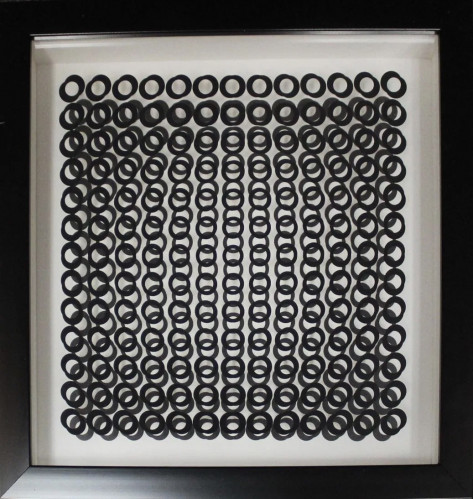
Details
Artist
Styles
Serigraph on Acitate Over Serigraph on Paper. Publishes by Editions du Griffon Neuchatel. Suite: Profound Works. Unsigned, unnumbered. Victor Vasarely’s Profound Works 7 (1973) is a striking example of Op Art, showcasing his mastery of geometric abstraction and optical illusion. Created using a layered technique—serigraph on acetate over serigraph on paper—the piece produces a dynamic interplay of depth and movement. A grid of black circular forms appears to warp and recede towards the center, creating a pulsating, three-dimensional effect that draws the viewer’s eye inward. The precision and repetition of shapes reflect Vasarely’s fascination with perception and spatial distortion. Published by Editions du Griffon Neuchatel as part of the Profound Works suite, this rare limited-edition print exemplifies his exploration of visual kinetics and the illusion of motion within a static medium.
Profound Works 7, 1973
form
Medium
Size
29.8 x 29.8 cm
- Inches
- Centimeters
Edition
Price
Details
Artist
Styles
Serigraph on Acitate Over Serigraph on Paper. Publishes by Editions du Griffon Neuchatel. Suite: Profound Works. Unsigned, unnumbered. Victor Vasarely’s Profound Works 7 (1973) is a striking example of Op Art, showcasing his mastery of geometric abstraction and optical illusion. Created using a layered technique—serigraph on acetate over serigraph on paper—the piece produces a dynamic interplay of depth and movement. A grid of black circular forms appears to warp and recede towards the center, creating a pulsating, three-dimensional effect that draws the viewer’s eye inward. The precision and repetition of shapes reflect Vasarely’s fascination with perception and spatial distortion. Published by Editions du Griffon Neuchatel as part of the Profound Works suite, this rare limited-edition print exemplifies his exploration of visual kinetics and the illusion of motion within a static medium.
- Recently Added
- Price (low-high )
- Price (high-low )
- Year (low-high )
- Year (high-low )
What is Hard Edge Art?
Hard Edge art is a style of abstract painting that became popular in the 1960s. It features areas of color separated by crisp, sharp edges that are painted with geometric precision. The term hard-edge painting was coined by art critic Jules Langsner to describe this approach, which contrasts with the softer, more fluid forms of other abstract styles.






































































